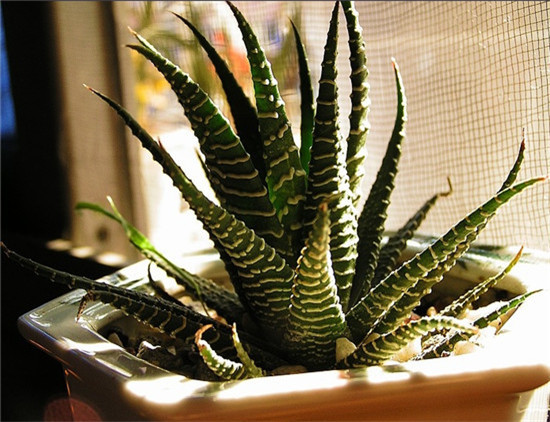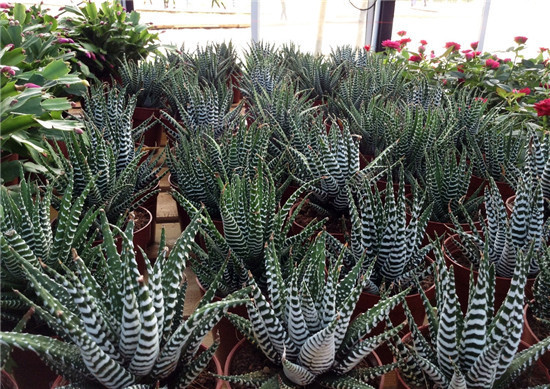Cultivation method of twelve stripes
Striped twelve volumes, also known as Caragana tail, Rooster tail, are perennial succulent herbs of Liliaceae. Next, let's take a look at the cultivation method of twelve volumes of stripes.

The twelve striped leaves are closely whorled on the stem axis, showing a rosette; the leaves are triangular-lanceolate, apex acute; the leaf surface is smooth, dark green; the back of the leaf is green, with large white verrucous protuberances, which are arranged into horizontal stripes, in sharp contrast to the dark green of the leaf surface. It has good ornamental value.
Ramet propagation of twelve rolls of stripes
Ramet time: preferably after soil thawing in early spring (February or March).
Split method: take the mother plant out of the flowerpot, shake off the excess potted soil, separate the root system as much as possible, cut it into two or more plants with a sharp knife, and each plant should have a considerable root system. and its leaves are properly trimmed to facilitate survival.
Disinfection in a basin: soak the divided plants in 1500 times chlorothalonil solution for five minutes, then take out and dry, and then put on the basin. You can also irrigate the root with chlorothalonil immediately after potting.
Management after ramet: put the ramet into the basin and irrigate the root or irrigate once. Because its root system is greatly damaged and its water absorption capacity is very weak, it takes about 3-4 weeks to recover new roots. Therefore, it is necessary to control watering within 3-4 weeks after ramet to avoid rotting roots, but the transpiration of its leaves is not affected. In order to maintain the water balance of the leaves, it is necessary to spray the leaf surface 1-3 times a day (spray more at high temperature, less spray at low temperature or no spray at low temperature). Don't fertilize it these days. After the split, but also pay attention to the sun is too strong, it is best to put in the shade to maintain.

The culture method of stripe twelve rolls:
1. Soil: the twelve volumes of stripes are not strict with the soil, and the fertile and loose sandy loam soil is suitable for pot cultivation, because the root system is shallow, shallow planting is better, and the rotten leaf soil with fertile and good drainage is mixed with coarse sand.
2. Watering: twelve stripes can keep the basin soil moist during the growing period, and during the semi-dormant period of winter and midsummer, it is appropriate to dry and strictly control watering. The basin soil is too wet in winter, which is easy to cause root rot and leaf atrophy.
3. Sunshine: the leaf color will be more beautiful when the twelve stripes are kept in the semi-shade in summer, or when you shade it by 50%. In spring and autumn, because the temperature is not very high, it is necessary to give it direct sunlight to facilitate its photosynthesis to accumulate nutrients. In winter, keep it indoors where there is bright light for maintenance.

4. Temperature: the optimum growth temperature of striped twelve rolls is 15 ℃-32 ℃. It is afraid of high temperature and muggy heat, and goes into dormancy when the summer temperature is above 33 ℃. Avoid cold frost, the overwintering temperature needs to be kept above 10 ℃, and when the winter temperature drops below 7 ℃, it will also enter a dormant state. If the ambient temperature is close to 4 ℃, it will die of frostbite.
5. Fertilization: the 12 rolls of stripes do not like fertilizer very much, and only need to apply thin fertilizer 1-2 times a year in spring to meet the needs.
6. Insect pests: root rot and brown spot sometimes occur in 12 volumes of stripes, which can be sprayed with 65% Dysen zinc wettable powder 1500 times. Insect pests are harmful to whiteflies and scale insects, which are sprayed with 1000 times of omethoate EC.

The above is all the contents of the cultivation methods of the twelve volumes of stripes that I have summarized for you. I hope this article can help you. Please continue to follow us.
Related
- Wuhan Hospital Iron Tree Blooming Result Was Instantly Frightened by the Gardener Master
- Which variety of camellia is the most fragrant and best? Which one do you like best?
- What is the small blue coat, the breeding methods and matters needing attention of the succulent plant
- Dormancy time and maintenance management of succulent plants during dormancy
- Minas succulent how to raise, Minas succulent plant pictures
- What are the varieties of winter succulent plants
- How to raise succulent plants in twelve rolls? let's take a look at some experience of breeding twelve rolls.
- Attention should be paid to water control for succulent plants during dormant period (winter and summer)
- Watering experience of twelve rolls of succulent plants
- Techniques for fertilizing succulent plants. An article will let you know how to fertilize succulent plants.



